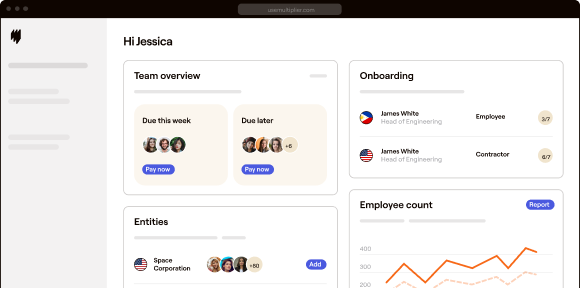HRIS stands for ‘human resources information system’. It’s an innovation that makes managing employees slick, streamlined, and less of a headache. And regardless of your business’s niche, you need an HRIS in your life.
In the digital age, HRIS technology exists to enhance every key aspect of human resources management, from hiring top-notch global talent to efficiently processing payroll, tracking employee performance, and beyond.
Oh yes, there is a treasure trove of HRIS benefits waiting for those who are willing to embrace this most intuitive of talent-facing technologies.
Intrigued? We bet you are.
Here we’re going to tell you everything you need to know about the key functions as well as business-boosting benefits of weaving HRIS technologies into your organizational ecosystem.
Ready? Great, let’s dive in.
The main functions of HRIS technology
Did you know? 725 of tip-top HR professionals state that using an HRIS system has significantly improved their general productivity. Not too shabby.
Yes, working with the right HRIS technology comes with its fair share of advantages (but more on that later).
Before we explore HRIS benefits, we’re going to look at the key functions and components of any human resources information system worth its salt.
1. Applicant tracking systems (ATS)
Without a doubt, one of the essential elements of successful workforce management is nailing the applicant journey.
Handling the applicant tracking process is essential if you want to maintain a solid brand reputation and retain the best global talent for your business. Fortunately, the best HRIS technology is equipped with ATS capabilities that will empower you to streamline the application process, from processing resumes to communicating with candidates, and matching the right talent to the right job vacancies.
2. Employee data management
Armed with the right HRIS data and insights, you can track key metrics like staff turnover, attendance levels, and engagement rates.
HRIS platforms will also empower you to track individual performance to provide tailored support, guidance, and training where necessary. Yes, HRIS reporting will improve your employee management efforts in a big way—helping you to retain the best talent for your business as a result.
3. Payroll processing
Without a swift and seamless means of processing payroll (especially if you have a global workforce), you could find yourself in reputational as well as financial hot water.
HRIS payroll systems automate key parts of the staff payment process to ensure everyone is paid on time, in the right currency, and with complete compliance without eating into your time or budget. It’s a win-win-win.
4. Employee self-service
The best modern HRIS systems offer key employee self-service features and functionality. So, your workers can take charge of holiday requests, logging issues, and updating their personal information with ease, through one unified system.
Self-service is an incredibly important feature of an HRIS system as it ultimately saves human resources serious admin time while significantly improving the employee experience.
Did you know? A shocking 65% of HR’s time was once eaten up processing employee requests and information. Not in the age of the HRIS.
5. Benefits administration
Arguably, benefits administration is one of the biggest HRIS rewards of the modern age. Benefits are integral to retaining your best talent and creating a company culture that sings.
Armed with a top-notch piece of HRIS technology, you can give your employees self-service access to their benefits, offering the autonomy to take advantage of them with a few swipes of a screen or clicks of a button. Bonus.
6. Succession planning
HRIS systems are equipped with the capabilities to help you visualize and streamline your succession planning activities with ease.
In doing so, you can create an effective talent pipeline that empowers people to progress within the organization while filling in any gaps related to new or existing roles swiftly and with confidence.
7. Time and attendance tracking
Equipped with automated time and attendance tracking features, modern HRIS technology will help you ensure you pay your staff with pinpoint accuracy (especially if a portion of your employee base works shifts).
Plus, you can tackle tardiness while discovering trends or patterns you might need to address to manage your employees more effectively.
8. Reporting & analytics
In addition to getting your hands on some pretty priceless employee data, HRIS systems also serve up tasty insights on key HR-related areas, including…
- Productivity
- Stakeholder value
- KPIs and performance metrics
- Processing times
- Talent acquisition trends
- Employee progression
- Financial data
Everything you need to succeed…analytically speaking.
HRIS vs. HRMS vs. HCM: Understanding the differences
Before implementing HRIS to level up some of your most essential business processes, it pays to know the difference between HRIS, HRMS, and HCM.
Let’s explore.
1. HCM key features
An HCM is a system that hones in on particularly employee-facing parts of the human resources pie. Its key features include…
- Tracking applicant progress during the hiring process
- Core budget planning and projections
- Organizing staff training initiatives
- Absentee data processing
2. HRMS key features
This pretty handy piece of HR tech is focused on talent performance and development initiatives. Here are the main bells and whistles you usually see in any solid HRMS platform…
- Talent performance management and strategy
- Employee progression and succession planning
- Recruitment optimization and strategy
- End-to-end onboarding
3. HRIS key features
Hang on a second…we’ve already been through the key features of modern HRIS technology. And, as you can see, the HRIS is capable of tackling all of the processes and initiatives of a HCM and a HRMS, but with additional capabilities, including benefits administration, global payroll, and self-service employee functionality.
There are countless HRIS benefits to speak of, mainly because of the technology’s interactive and all-encompassing nature.
If you have a small business with very specific talent-centric goals, an HCM or HRMS may well meet your needs. But, if you’re looking to scale seamlessly while developing a company culture that helps your organization thrive, the HRIS ticks all of the boxes.
Read: Our guide to understanding the role of culture in international business for insider advice and information that will ensure your company continues to grow and evolve.
HRIS technology: What goes on behind the scenes?
Now that you know the difference between an HCM, HRMS, and HRIS, we’re going to take a little peek under the virtual hood.
Knowing what goes on behind the scenes will help you understand the advantages of HRIS on a deeper, more practical level.
So, what goes on behind the scenes of a human resources information system, exactly?
Let’s take a look.
1. Database management
Akin to a modern customer relationship system (CRM), HRIS technology facilitates an extensive range of human resources-based initiatives by processing, curating, and visualizing colossal sets of employee data based on a wealth of functions or processes.
The HRIS takes raw HR data, cleans it up, and presents it in an accessible digital format that helps to improve areas, including payroll, strategic decision-making, employee performance, compliance, and engagement.
By taking data from a range of sources, an HRIS consolidates everything into one centralized hub for essential HR reporting and analysis processes.
2. Security and data protection
Did you know? Today’s security breaches cost companies across sectors an average of $4.35 million. That’s no small potatoes.
Considering the potential devastation information or data breaches can cause businesses, keeping your security water-tight is a top priority when implementing HRIS.
To protect colossal sets of sensitive employee data from being leaked or hacked, modern HRIS technology and systems are developed with certain protective measures—including:
- Automatic system upgrades and updates
- Security breach alerts and shutdown measures
- Stringent authentication measures
- Security or data patch applications
- End-to-end encryption
3. Cloud-based vs. on-premises HRIS solutions
In today’s digital world, you can enjoy the advantages of HRIS by using cloud-based or on-premises solutions.
Both have a certain level of flexibility in terms of geographical reach. But, depending on your company’s size, scope or organizational structure, knowing which one to choose will ensure you get plenty of bang for your organizational buck.
As a general rule of thumb, on-premises HRIS technology will prove more effective if your business runs from a central office or location. In this case, you would need an appropriate level of tech support, servers, and additional resources to keep it running smoothly (and securely).
The cloud-based HRIS solution provides an equal level of scope and depth in terms of functionality and capabilities, but it’s completely remote. Whether you’re a remote or hybrid business looking to scale while broadening your international employee base, a cloud-based solution will offer you the best possible return on investment (ROI).
Case study: Check out our case study on DB Results and discover how working with the right HRIS solution helped elevate the company’s success in the Philippines.
4. HRIS payroll processing: Streamlining compensation management
When it comes to payroll, the right HRIS will deliver. In addition to functionality that ensures 100% compliance across geographic borders, implementing HRIS throughout your businesses will also streamline all key elements of your compensation processes.
Paying international talent can be a complex, confusing, and potentially risky business. But, with smart automation processes and secure, accessible interfaces, its HRIS payroll is usually swift, safe, and painless.
Modern HRIS payroll systems collate employee payment data and arrange it into a centralized location—pulling essential compensation data as and when needed. Using an HRIS tailored to your company’s needs, it’s also possible to set up payroll in multiple currencies using simple drop-down features. And because all payroll data is encrypted, it’s protected from the ongoing threat of cybercrime.
But, while HRIS payroll does offer a treasure trove of business-boosting, there are some essential challenges to consider.
Naturally, there is always (as mentioned) the threat of cybercrime to consider. As such, keeping your HRIS payroll system up to date at all times is critical. Implementing HRIS payroll can also prove challenging, particularly when it comes to integrating the technology with existing platforms within your ecosystem.
But, while this may be the case, the pros do indeed outweigh the cons. And, by understanding these common HRIS payroll challenges in advance, you can make the preparations you need to troubleshoot any potential issue as it arises.
The future of HRIS technology
While 40% of hard-working Americans live in fear that artificial intelligence (in particular, the likes of ChatGPT) is going to steal their job. But in the case of HR technology and chiefly, HRIS—working in harmony with autonomous technologies can actually serve to improve day-to-day working life.
AI is the hot HR trending topic on everyone’s (everyone in HR, at least) lips right now. And, from what we’ve discussed concerning the nuts and bolts of HR so far, it’s easy to see why.
Driven by autonomous technology, we’re likely to see these HRIS trends emerge in the not-so-distant future:
- Smart talent sourcing and selection processes
- Extensive self-service internal training and development features and platforms
- More engagement tools and social interaction elements to HRIS
- A move towards far more detailed and all-encompassing HR analytics capabilities for continual top-level strategic planning intelligence
- The emergence of internal talent marketplaces
The emergence of internal talent marketplaces will be a significant development in HR technology as it will empower employees to showcase talent beyond their existing roles. By gaining the ability to get matched to extracurricular projects within their organizations, not only will they become more motivated, but the business as a whole will thrive as a result.
And, these potentially fruitful internal talent marketplaces will be made possible by the (not so) humble HRIS system.
We expect to see a raft of AI-inspired changes to the HR landscape over the coming years, many of which will serve to aid and assist executives as well as employees in their daily duties and activities.
Read: Our essential guide to emerging trends in human resource management to help your finger well truly on the HR pulse.
HRIS technology: final thoughts
“The coach doesn’t have to play the sport as well as you do. They have to watch you and get you to be your best.”—Eiric Schmidt
A forward-thinking business commands forward-thinking solutions. Without a doubt, human resources are the beating heart of your entire business.
Without the right talent, a strong inclusive culture—and the means to continue optimizing and evolving your people-centric processes, you’ll find yourself wading through hot water pretty quickly.
Armed with the right HRIS technology, you’ll ensure your organization keeps pushing forward while remaining productive, compliant, and financially efficient. The key ingredients to success in today’s fast-paced digital age.
We hope this guide has proved valuable, and for more insider tips from Multiplier HQ, check out our must-read guide on HRIS implementation strategies.
FAQs on HRIS
Q. How does HRIS improve employee management?
An HRIS comes with its fair share of business-boosting benefits—especially when it comes to improving the employee experience.
With an accessible interface and a raft of self-service features, the mighty HRIS empowers employees to take charge of their benefits by accessing them through a unified platform. An HRIS also streamlines certain employee-centric processes by allowing people to request leave and log essential information with ease, saving time and friction in the process.
Q. Is HRIS suitable for small businesses?
Yes—100%. Armed with the right HRIS, a small business will enjoy a healthy return on investment (ROI).
The right HRIS technology will improve the employee experience you offer (hello, staff retention), serve up invaluable HR insights, and scale with your business as it grows. In fact, choosing the right HRIS system could help your business scale faster.
Q. What is the cost of implementing an HRIS?
According to a mix of studies, implementing an HRIS costs an average of $20 to $30 per employee per month (PEPM) if you choose a system with HRIS payroll functionality. Generally, basic HRIS technology systems weigh in at around $6 to 12 dollars PEPM.
Q. Are there any security risks associated with HRIS?
While using an HRIS for your business can offer a host of benefits, cybersecurity risks do exist. Data breaches are rife in the digital age, and every HRIS system can have its vulnerabilities.
But, by updating your system regularly and investing in a supplier who is 100% security compliant, you can minimize the risk of potentially devastating data leaks or security breaches.
Q. How can businesses ensure data privacy with HRIS?
To ensure data privacy with HRIS, you should invest in technology or suppliers with cybersecurity at heart.
The best HRIS systems are 100% compliant with industry data protection standards and offer stringent encryption in transit and at rest. Never use a HRIS system that isn’t known for its commitment to data privacy.







